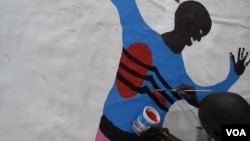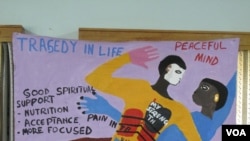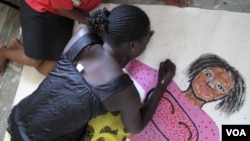NAIROBI – One of the biggest challenges for people living with HIV is the daily stigma and discrimination they face from society. Since 2005, a Belgian visual artist has been using a form of art therapy to help HIV-positive Kenyans deal with this stress.
Gideon, 40, is a Kenyan living with HIV. He learned his status in 2005, when he was hospitalized for another ailment.
Gideon says that when his family learned his status, some wanted him to leave Nairobi and go back to his hometown, Kisii, to save them the expense of transporting his casket later.
"They were encouraging me to move up, to up-country, to wait for my big day," he explained. "But I was not able to go. I told them, 'let me die here, that's where people know me.'"
This sort of reaction is common in Kenya, once a person with HIV has disclosed his or her status explains Xavier Verhoest, a visual artist who helps through a form of art therapy called body mapping.The program is completed in five days.
Verhoest and his counseling team create a safe space for participants by providing them a non-judgmental environment and counseling services.
The participants first have a partner draw an outline of their bodies on a large canvas. Throughout the seminar, Verhoest asks them questions about their lives, including childhood, family, stress, and support systems. Participants respond by drawing on the canvas.
"We live as well in a place where there's not much space for expression," said
Verhoest. "There's a huge culture of silence here in Kenya, but when you talk about stigmatization all over the world, it's something very, very common. When you talk to people living with HIV, they're not going to come out that easily. So the fact that we create a space where people feel very confident in expressing important issues in their lives help people to accept as well some of the issues they've been dealing with."
Mary, 27, is a former commercial sex worker. Although she is not HIV-positive, it is constantly on her mind.
"A lot of times. When you see a sign board of HIV, you just feel, whew. Maybe I'm one of them. Just like that," she said.
Mary went through the body mapping program in 2010. Like those living with HIV, she says that she faces constant discrimination.
"We used to use colors, so in my body mapping, I used red color a lot, and black color. Because, when I was using [a] red color, I was showing them the things that make me feel bad," she explained. "Black is darkness. You're always in the darkness. The society doesn't see you like a human being, since you are a sex worker. Those discrimination, abusive language used upon you, me, I used red and black. But in this way, I had my kids, I drew my kids, I used a green color, and again, I used yellow color. You see, yellow is, it was a symbol of sun. The sun can shine on you even if you are a sex worker or people are discriminating you."
Source: CIA World Factbook, 2009 estimates
Gideon lives in the Nairobi slum, Kibera, where life is already quite difficult for residents. Living with HIV does not make things easier. But, he says that body mapping has helped him in his everyday life.
"But once I went to the body mapping session, after going through, I was able to transfer all the pain I was going through, the emotional feelings I had, to the body map," Gideon said. "Once I had done all those things in a day, I was feeling that I was getting a fresh life in me. I was getting light and young."
Gideon, 40, is a Kenyan living with HIV. He learned his status in 2005, when he was hospitalized for another ailment.
Gideon says that when his family learned his status, some wanted him to leave Nairobi and go back to his hometown, Kisii, to save them the expense of transporting his casket later.
"They were encouraging me to move up, to up-country, to wait for my big day," he explained. "But I was not able to go. I told them, 'let me die here, that's where people know me.'"
This sort of reaction is common in Kenya, once a person with HIV has disclosed his or her status explains Xavier Verhoest, a visual artist who helps through a form of art therapy called body mapping.The program is completed in five days.
Verhoest and his counseling team create a safe space for participants by providing them a non-judgmental environment and counseling services.
The participants first have a partner draw an outline of their bodies on a large canvas. Throughout the seminar, Verhoest asks them questions about their lives, including childhood, family, stress, and support systems. Participants respond by drawing on the canvas.
"We live as well in a place where there's not much space for expression," said
Verhoest. "There's a huge culture of silence here in Kenya, but when you talk about stigmatization all over the world, it's something very, very common. When you talk to people living with HIV, they're not going to come out that easily. So the fact that we create a space where people feel very confident in expressing important issues in their lives help people to accept as well some of the issues they've been dealing with."
Mary, 27, is a former commercial sex worker. Although she is not HIV-positive, it is constantly on her mind.
"A lot of times. When you see a sign board of HIV, you just feel, whew. Maybe I'm one of them. Just like that," she said.
Mary went through the body mapping program in 2010. Like those living with HIV, she says that she faces constant discrimination.
"We used to use colors, so in my body mapping, I used red color a lot, and black color. Because, when I was using [a] red color, I was showing them the things that make me feel bad," she explained. "Black is darkness. You're always in the darkness. The society doesn't see you like a human being, since you are a sex worker. Those discrimination, abusive language used upon you, me, I used red and black. But in this way, I had my kids, I drew my kids, I used a green color, and again, I used yellow color. You see, yellow is, it was a symbol of sun. The sun can shine on you even if you are a sex worker or people are discriminating you."
Countries with Largest Number of People Living with HIV
Countries with Largest Number of People Living with HIV Infections- South Africa - 5,600,000
- Nigeria - 3,300,000
- India - 2,400,000
- Kenya - 1,500,000
- Mozambique - 1,400,000
- Tanzania - 1,400,000
- Zimbabwe - 1,200,000
- Uganda - 1,200,000
- United States - 1,200,000
- Russia - 980,000
Source: CIA World Factbook, 2009 estimates
"But once I went to the body mapping session, after going through, I was able to transfer all the pain I was going through, the emotional feelings I had, to the body map," Gideon said. "Once I had done all those things in a day, I was feeling that I was getting a fresh life in me. I was getting light and young."











